type
status
date
slug
summary
tags
category
icon
password
原文:
We've all heard that product-market fit drives startup success — and that the lack thereof is what's lurking behind almost every failure.
我们都听说过产品市场匹配推动创业成功——而缺乏这种匹配则是几乎每次失败背后潜藏的原因。
For founders, achieving product-market fit is an obsession from day 1. It's both the hefty hurdle we're racing to clear and the festering fear keeping us up at night, worried that we'll never make it. But when it comes to understanding what product/market fit really is and how to get there, most of us quickly realize that there isn't a battle-tested approach.
对于创始人来说,从第一天起实现产品市场契合就是一种执念。这既是我们急于跨越的巨大障碍,也是让我们彻夜难眠的挥之不去的恐惧,担心我们永远无法实现。但当涉及到理解什么是真正的产品/市场契合以及如何达成时,我们大多数人很快就意识到,并没有一个经过实战检验的方法。
In the summer of 2017, I was waist-deep in my search for a way to find product-market fit for my startup, Superhuman. Turning to the classic blog posts and seminal thought pieces, a few observations stuck out to me. Y Combinator founder Paul Graham described product-market fit as when you've made something that people want, while Sam Altman characterized it as when users spontaneously tell other people to use your product. But of course, the most cited description comes from this passage in Marc Andreessen's 2007 blog post:
2017 年夏天,我正深陷于为我的创业公司 Superhuman 寻找产品市场契合度的搜索中。翻阅经典博客文章和重要思想作品时,有几个观察结果引起了我的注意。Y Combinator 创始人 Paul Graham 将产品市场契合度描述为当你制造了人们想要的东西时的状态,而 Sam Altman 则将其描述为当用户自发地告诉其他人使用你的产品时的情况。但当然,最常被引用的描述来自 Marc Andreessen 2007 年博客文章中的这段话:
You can always feel when product-market fit is not happening. The customers aren't quite getting value out of the product, word of mouth isn't spreading, usage isn't growing that fast, press reviews are kind of 'blah', the sales cycle takes too long, and lots of deals never close.
当产品市场契合度不高时,你总能感觉得到。客户无法从产品中获得足够的价值,口碑传播不起来,使用率增长缓慢,媒体评论平平无奇,销售周期拖得太长,许多交易最终都无法成交。
And you can always feel product-market fit when it is happening. The customers are buying the product just as fast as you can make it — or usage is growing just as fast as you can add more servers. Money from customers is piling up in your company checking account. You're hiring sales and customer support staff as fast as you can. Reporters are calling because they've heard about your hot new thing and they want to talk to you about it. You start getting entrepreneur of the year awards from Harvard Business School. Investment bankers are staking out your house.
当产品市场匹配发生时,你总能感觉到。客户购买产品的速度与你生产的速度一样快——或者使用量的增长与你添加服务器的速度一样快。来自客户的资金在你公司的支票账户中不断积累。你正在以最快的速度雇佣销售和客户支持人员。记者们打来电话,因为他们听说了你的热门新产品,想要与你谈谈。你开始获得哈佛商学院颁发的年度企业家奖项。投资银行家们开始在你家门口蹲守。
For me, this was the most vivid definition — and one that I stared at through tears.
对我来说,这是最生动的定义——我含着泪凝视着它。
We had set up shop and started coding Superhuman in 2015. A year later, our team had grown to seven and we were still furiously coding. By the summer of 2017, we had reached 14 people — and we were still coding. I felt intense pressure to launch, from the team and also from within myself. My previous startup, Rapportive, had launched, scaled and been acquired by LinkedIn in less time. Yet here we were, 2 years in, and we had not passed go.
我们在 2015 年成立公司并开始编写 Superhuman 的代码。一年后,我们的团队已经发展到 7 人,我们仍在疯狂编码。到 2017 年夏天,我们已经达到 14 人——我们依然在编码。我感受到来自团队和自身的巨大压力,要求我们尽快推出产品。我之前的创业公司 Rapportive 在更短的时间内就已经推出、扩张并被 LinkedIn 收购。然而在这里,我们已经投入两年时间,却还没有取得突破。
But no matter how intense the pressure, I wasn't ready to launch. Common practice would be to "throw it out there and see what sticks", which may be fine after a few months of effort when the sunk cost is low. But the "launch and see what happens" method seemed irresponsible and reckless to me — especially given the years that we had invested.
但无论压力多大,我还没准备好发布。通常的做法是"先扔出去看看效果如何",这在付出几个月努力、沉没成本较低的情况下可能没问题。但对我来说,"发布然后看看会发生什么"的方法似乎不负责任且鲁莽——尤其考虑到我们已经投入了数年时间。

Further compounding the pressure, as a founder, I couldn't just tell the team how I felt. These super-ambitious engineers had poured their hearts and souls into the product. I had no way of telling the team we weren’t ready, and worse yet, no strategy for getting out of the situation — which is not something they would want to hear. I wanted to find the right language or framework to articulate our current position and convey the next steps that would get us to product-market fit, but was struggling to do so.
作为创始人,我不能直接向团队表达我的感受,这进一步加剧了压力。这些雄心勃勃的工程师们已经将他们的心血倾注到产品中。我无法告诉团队我们还没有准备好,更糟糕的是,我没有摆脱这种局面的策略——这是他们不想听到的。我想找到合适的语言或框架来阐明我们当前的处境,并传达能让我们达到产品市场契合的下一步措施,但我正在为此苦苦挣扎。
That's because the descriptions of product-market fit I found were immensely helpful for companies post-launch. If, after launch, revenue isn't growing, raising money is tough, the press doesn't want to talk to you and user growth is anemic, then you can safely conclude you don't have product-market fit. But in practice, because of my previous success as a founder, we didn't have problems raising money. We could have gotten press, but we were actively avoiding it. And user growth wasn't happening because we were deliberately choosing not to onboard more users. We were pre-launch — and we didn't have any indicators to clearly illustrate our situation.
这是因为我发现的产品市场契合度描述对于已上市的公司非常有帮助。如果在上市后,收入没有增长,融资困难,媒体不愿意与你交谈,用户增长缓慢,那么你可以安全地得出结论,你没有实现产品市场契合。但实际上,由于我之前作为创始人的成功经历,我们在融资方面并没有遇到问题。我们本可以获得媒体报道,但我们主动避免了。而用户增长没有发生是因为我们故意选择不吸纳更多用户。我们处于上市前阶段——我们没有任何明确的指标来说明我们的情况。
What if you could measure product-market fit?
如果您能够衡量产品与市场的契合度会怎样?
The descriptions of product-market fit all seemed so post hoc, so unactionable. I had a clear understanding of where we stood, but I had no way of conveying that to others — and no plan for the part that should come next.
对产品市场契合度的描述似乎都是事后诸葛亮,缺乏可行性。我清楚地了解我们所处的位置,但我无法向他人传达这一点,也没有下一步行动的计划。
So I racked my brain for an answer on how to travel the distance between where Superhuman was and the high bar that we needed to hit. And I eventually started to wonder: what if you could measure product-market fit? Because if you could measure product/market fit, then maybe you could optimize it. And then maybe you could systematically increase product-market fit until you achieved it.
所以我绞尽脑汁寻找答案,如何跨越 Superhuman 当前所处的位置与我们需要达到的高标准之间的距离。最终我开始思考:如果能够衡量产品与市场的契合度会怎样?因为如果你能衡量产品与市场的契合度,那么也许你就能优化它。然后也许你就能系统地提高产品与市场的契合度,直到达成目标。
Reoriented around this purpose and reinvigorated by the new direction, I set out to reverse-engineer a process for getting to product-market fit. Below, I outline the findings that followed, specifically unpacking the clarifying metric that made everything fall into place and the 4-step process we used to build an engine that propelled Superhuman forward on the path to finding our fit.
围绕这个目标重新定位并因新方向而焕发活力后,我着手反向设计一个达到产品市场契合的过程。以下,我概述了随之而来的发现,特别是解析了使一切落入正轨的明确指标,以及我们用来构建推动 Superhuman 前进,寻找契合度的四步流程。
Anchoring around a metric: a leading indicator for product-market fit
围绕一个指标进行锚定:产品市场契合度的领先指标
On my quest to understand product-market fit, I read all I could and spoke with every expert I could find. Everything changed when I found Sean Ellis, who ran growth in the early days of Dropbox, LogMeIn, and Eventbrite and later coined the term "growth hacker".
在我寻求理解产品市场契合度的过程中,我阅读了所有能找到的资料,并与每一位我能找到的专家交谈。当我遇到 Sean Ellis 时,一切都改变了。他曾在 Dropbox、LogMeIn 和 Eventbrite 的早期负责增长,后来还创造了"增长黑客"这个术语。
The product-market fit definitions I had found were vivid and compelling, but they were lagging indicators — by the time investment bankers are staking out your house, you already have product-market fit. Instead, Ellis had found a leading indicator: just ask users "how would you feel if you could no longer use the product?" and measure the percentage who answer "very disappointed".
我发现的产品市场契合度定义虽然生动有力,但它们都是滞后指标——当投资银行家开始在你家门口蹲守时,你已经实现了产品市场契合。相反,Ellis 找到了一个领先指标:只需询问用户"如果你不能再使用这个产品,你会有什么感觉?"并测量回答"非常失望"的用户比例。
After benchmarking nearly 100 startups with his customer development survey, Ellis found that the magic number was 40%. Companies that struggled to find growth almost always had less than 40% of users respond "very disappointed", whereas companies with strong traction almost always exceeded that threshold.
在对近 100 家初创公司进行客户开发调查的基准测试后,Ellis 发现神奇数字是 40%。那些难以实现增长的公司,回答"非常失望"的用户几乎总是少于 40%,而那些发展强劲的公司几乎总是超过这个阈值。
Ask your users how they'd feel if they could no longer use your product. The group that answers 'very disappointed' will unlock product-market fit.
询问你的用户,如果他们不能再使用你的产品会有什么感受。回答"非常失望"的那群人将会揭示产品与市场的契合度。
A helpful example comes from Hiten Shah, who posed Ellis' question to 731 Slack users in a 2015 open research project. 51% of these users responded that they would be very disappointed without Slack, revealing that the product had indeed reached product-market fit when it had around half a million paying users. Today, this isn’t too surprising, given Slack's legendary success story. Truly, this example shows just how hard it is to beat the 40% benchmark.
一个有帮助的例子来自 Hiten Shah,他在 2015 年的一项公开研究项目中向 731 名 Slack 用户提出了 Ellis 的问题。51%的用户回答说,如果没有 Slack 他们会非常失望,这表明当 Slack 拥有约 50 万付费用户时,该产品确实已经达到了产品市场契合。今天,考虑到 Slack 传奇般的成功故事,这并不太令人惊讶。确实,这个例子显示了要超越 40%的基准有多么困难。
Inspired by this approach, we set out to measure what the responses would be for Superhuman. We identified users who recently experienced the core of our product, following Ellis' recommendation to focus on those who used the product at least twice in the last 2 weeks. (At the time we had between 100 and 200 users to poll, but smaller, earlier-stage startups shouldn't shy away from this tactic — you start to get directionally correct results around 40 respondents, which is much less than most people think.)
受此方法启发,我们着手测量 Superhuman 的用户反馈。我们确定了最近体验过我们产品核心功能的用户,遵循 Ellis 的建议,聚焦于过去两周内至少使用过两次产品的用户。(当时我们有 100 到 200 名用户可供调查,但规模较小、处于早期阶段的初创公司也不应回避这种策略——在大约 40 名受访者时就能开始得到大致正确的结果,这比大多数人想象的要少得多。)
We then emailed these users a link to a Typeform survey asking the following four questions:
然后我们通过电子邮件向这些用户发送了一个 Typeform 调查链接,询问以下四个问题:
1. How would you feel if you could no longer use Superhuman?
A) Very disappointed
B) Somewhat disappointed
C) Not disappointed1.
如果你不能再使用 Superhuman,你会有什么感受?
A) 非常失望
B) 有些失望
C) 不失望
2. What type of people do you think would most benefit from Superhuman?
2. 你认为哪类人最能从 Superhuman 中受益?
3. What is the main benefit you receive from Superhuman?
3. 使用 Superhuman 的主要好处是什么?
4. How can we improve Superhuman for you?
4. 我们如何能为您改进 Superhuman?
With the responses collected, we analyzed the first question:
收集到回复后,我们分析了第一个问题:
.png?t=6fb99159-fe52-4c47-8c47-0ac36d826cfd)
With only 22% opting for the "very disappointed" answer, it was clear that Superhuman had not reached product-market fit. And while this result may seem disheartening, I was instead energized. I had a tool to explain our situation to the team and — most excitingly — a plan to boost our product-market fit.
仅有 22%的人选择"非常失望"的回答,这清楚地表明 Superhuman 还没有达到产品市场契合。虽然这个结果可能看起来令人沮丧,但我反而感到充满活力。我有了一个工具来向团队解释我们的情况,而且——最令人兴奋的是——有了一个提升我们产品市场契合度的计划。
From benchmark to engine: the 4-step manual for optimizing product-market fit
从标杆到引擎:优化产品市场契合度的 4 步操作手册
Determined to move the needle, I became singularly focused on ways to improve our product-market fit score. The responses to each survey question would be key ingredients in what became the framework for fulfilling our goal.
决心要有所突破,我全神贯注地寻找提高我们产品市场契合度评分的方法。每个调查问题的回答都将成为实现我们目标框架的关键要素。
Here are the 4 components that comprised our product-market fit engine:
以下是构成我们产品市场契合引擎的 4 个组成部分:
1. Segment to find your supporters and paint a picture of your high-expectation customers
1. 细分市场以找到您的支持者,并描绘出您的高期望客户画像
With your early marketing, you may have attracted all kinds of users — especially if you've had press and your product is free in some way. But many of those people won't be well-qualified; they don't have a real need for your product, and its main benefit or use case might not be a great fit. You wouldn't have wanted these folks as users anyway.
在早期营销中,你可能吸引了各种类型的用户——尤其是如果你获得了媒体报道,而且你的产品在某种程度上是免费的。但是这些人中的许多可能并不合格;他们并没有真正需要你的产品,而且产品的主要优势或使用场景可能并不适合他们。无论如何,你本来也不会想要这些人成为用户。
As an early-stage team, you could just narrow the market with preconceived notions of who you think the product is for, but that won't teach you anything new. If you instead use the "very disappointed" group of survey respondents as a lens to narrow the market, the data can speak for itself — and you may even uncover different markets where your product resonates very strongly.
作为早期团队,你可以仅凭对产品目标用户的预设想法来缩小市场范围,但这样做不会让你学到任何新东西。相反,如果你用调查中"非常失望"的受访者群体作为缩小市场的视角,数据就能自己说话——你甚至可能发现产品在不同市场中引起强烈共鸣的情况。
For me, the goal of segmenting was to find pockets in which Superhuman might have better product-market fit, those areas I may have overlooked or didn't think to scope down to.
对我来说,细分的目标是找到 Superhuman 可能有更好产品市场契合度的细分市场,这些领域可能是我忽视了或未曾考虑过要深入探讨的。
To start, we grouped the survey responses by their answer to the first question ("How would you feel if you could no longer use Superhuman?"):
首先,我们根据第一个问题的回答("如果你不能再使用 Superhuman,你会有什么感觉?")对调查回复进行了分组:
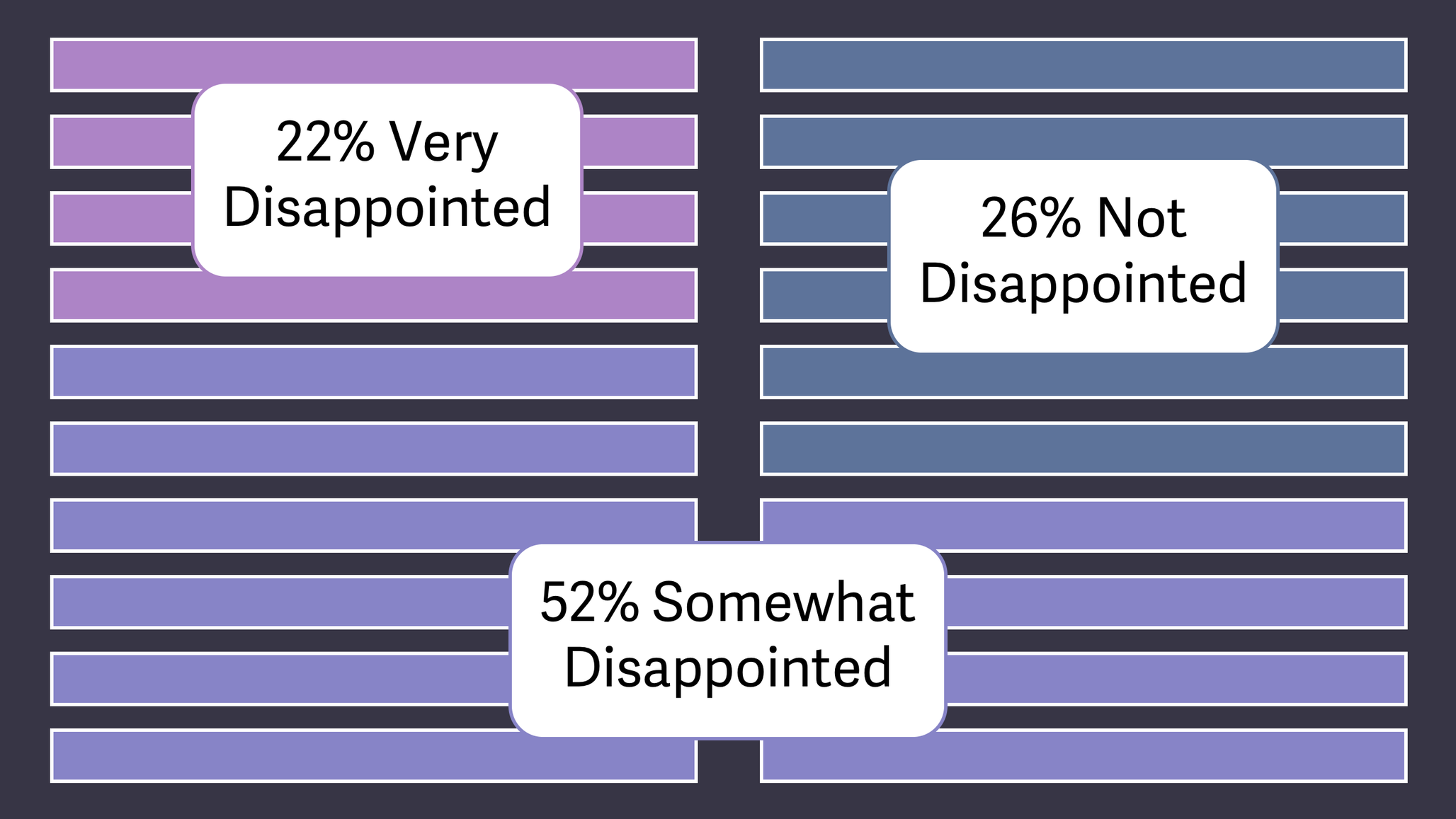
We then assigned a persona to each person who filled out a survey.
然后我们为每个填写调查问卷的人分配了一个角色。

Next, we looked at the personas that appeared in the very disappointed group — the 22% that were our biggest supporters — and used those to narrow the market. In this simplified example, you can see we focused on founders, managers, executives and business development — temporarily ignoring all other personas.接下来,我们查看了出现在非常失望群体中的角色——那 22%是我们最大的支持者——并用这些来缩小市场范围。在这个简化的例子中,你可以看到我们专注于创始人、经理、高管和业务发展人员——暂时忽略了所有其他角色。

With this more segmented view of our data, the numbers shifted. By segmenting down to the very disappointed group that loved our product most, our product-market fit score jumped by 10%. We weren’t quite at that coveted 40% yet, but we were a lot closer with minimal effort.
通过这种更细分的数据视角,数字发生了变化。通过将数据细分到最喜爱我们产品的非常失望群体,我们的产品市场契合度得分跃升了 10%。我们还没有达到那个令人垂涎的 40%,但是我们付出很少的努力就离目标更近了。
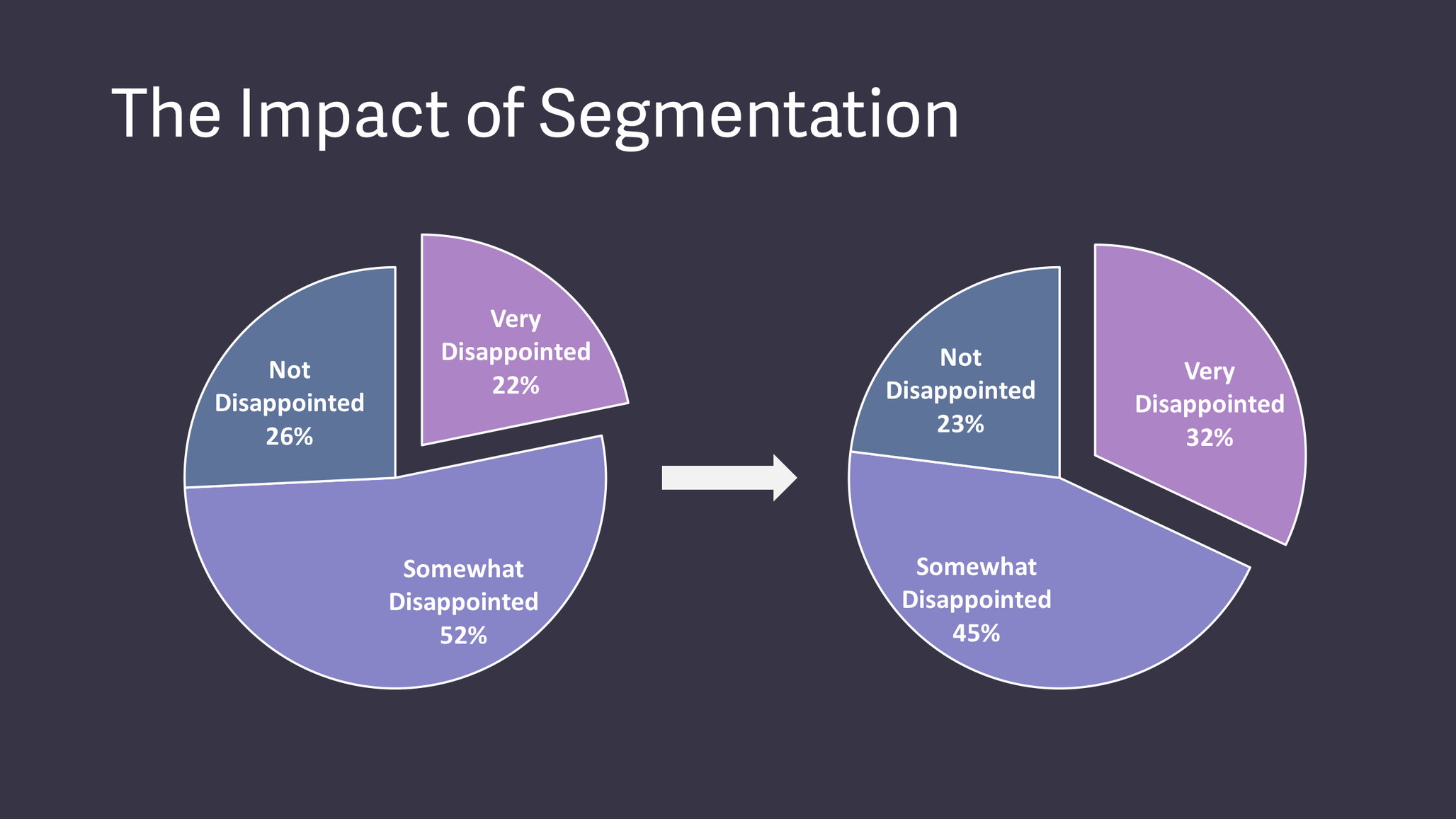
To go even deeper, I wanted to better understand these users who really loved our product. I hoped to paint as vivid a picture of them as possible, so I could galvanize the whole team to serve them better.
为了更深入地了解,我想更好地理解那些真正热爱我们产品的用户。我希望尽可能生动地描绘他们的形象,这样我就能激励整个团队更好地为他们服务。
I turned to Julie Supan's high-expectation customer framework as a tool to do just that. Supan notes that the high-expectation customer (HXC) isn't an all encompassing persona, but rather the most discerning person within your target demographic. Most importantly, they will enjoy your product for its greatest benefit and help spread the word. For example, Airbnb's HXC doesn’t simply want to visit new places, but wants to belong. For Dropbox, the HXC wants to stay organized, simplify their life, and keep their life's work safe.
我转向了朱莉·苏潘的高期望客户框架作为实现这一目标的工具。苏潘指出,高期望客户(HXC)并不是一个全面的角色,而是你目标人群中最挑剔的人。最重要的是,他们会因为产品的最大益处而喜欢你的产品,并帮助传播。例如,爱彼迎的 HXC 不仅仅想要游览新地方,还想要归属感。对于 Dropbox 来说,HXC 想要保持有序、简化生活,并保护他们一生的工作成果。
With this in mind, I sought to pinpoint Superhuman's HXC. We took only users who would be very disappointed without our product and analyzed their responses to the 2nd question in our survey: "What type of people do you think would most benefit from Superhuman?"
考虑到这一点,我试图找出 Superhuman 的 HXC。我们只选取了那些如果没有我们的产品会非常失望的用户,并分析了他们对我们调查中第二个问题的回答:"您认为哪类人最能从 Superhuman 中受益?"
This is a very powerful question, as happy users will almost always describe themselves, not other people, using the words that matter most to them. This lets you know who the product is working for and the language that resonates with them (providing valuable kernels of insight for your marketing copy as well).
这是一个非常有力的问题,因为满意的用户几乎总是会用对他们最重要的词语来描述自己,而不是其他人。这让你知道产品适合哪些人,以及哪些语言能引起他们的共鸣(同时也为你的营销文案提供了宝贵的洞察核心)。
Using our customers' words and Supan's tips for building a profile, we crafted a rich and detailed vision of the Superhuman HXC:
使用我们客户的话语和 Supan 的建立档案技巧,我们精心制作了一个丰富而详细的 Superhuman HXC 愿景:
Nicole is a hard-working professional who deals with many people. For example, she may be an executive, founder, manager, or in business development. Nicole works long hours, and often into the weekend. She considers herself very busy, and wishes she had more time. Nicole feels as though she's productive, but she's self-aware enough to realize she could be better and will occasionally investigate ways to improve. She spends much of her work day in her inbox, reading 100–200 emails and sending 15–40 on a typical day (and as many as 80 on a very busy one).
妮可是一位勤奋的专业人士,与许多人打交道。例如,她可能是一名高管、创始人、经理或从事业务开发工作。妮可工作时间很长,经常工作到周末。她认为自己非常忙碌,希望能有更多时间。妮可觉得自己很有效率,但她有足够的自我意识意识到自己还可以做得更好,偶尔会研究改进的方法。她的大部分工作日都花在收件箱上,在典型的一天里阅读 100-200 封电子邮件,发送 15-40 封(在非常忙的日子里可能会发送多达 80 封)。
Nicole considers it part of her job to be responsive, and she prides herself on being so. She knows that being unresponsive could block her team, damage her reputation, or cause missed opportunities. She aims to get to Inbox Zero, but gets there at most 2 or 3 times a week. Very occasionally — perhaps once a year — she'll declare email bankruptcy. She generally has a growth mindset. While she's open-minded about new products and keeps up to date with technology, she may have a fixed mindset about email. Whilst open to new clients, she's skeptical that one could make her faster.Nicole
认为及时回复是她工作的一部分,她为此感到自豪。她知道不回复可能会阻碍团队工作,损害她的声誉,或导致错失机会。她的目标是实现收件箱清零,但每周最多只能做到 2 到 3 次。很偶尔——也许一年一次——她会宣布邮件破产。她通常持有成长型思维模式。虽然她对新产品持开放态度并跟上技术发展,但在电子邮件方面可能有一个固定思维模式。尽管她愿意接受新客户,但对于有人能让她处理邮件更快这一点持怀疑态度。
With our HXC in mind, we had a tool to focus the entire company on serving that narrow segment better than anybody else. Some may find this approach too limiting, arguing that you shouldn't narrow in on such a specific customer base early on.
考虑到我们的 HXC,我们有一个工具来让整个公司专注于比其他任何人都更好地服务于这个狭窄的细分市场。有些人可能会认为这种方法过于局限,认为你不应该在早期就将目标缩小到如此具体的客户群。
It's a commonly held view that tailoring the product too narrowly to a smaller target market means that growth will hit a ceiling — but I don’t think that's the case.
人们普遍认为,将产品过于狭隘地定制于较小的目标市场意味着增长将遇到瓶颈——但我认为并非如此。
These words of wisdom from Paul Graham explain why:
Paul Graham 的这些智慧之言解释了原因:
When a startup launches, there have to be at least some users who really need what they're making — not just people who could see themselves using it one day, but who want it urgently. Usually this initial group of users is small, for the simple reason that if there were something that large numbers of people urgently needed and that could be built with the amount of effort a startup usually puts into a version 1, it would probably already exist. Which means you have to compromise on 1 dimension: you can either build something a large number of people want a small amount, or something a small number of people want a large amount. Choose the latter. Not all ideas of that type are good startup ideas, but nearly all good startup ideas are of that type.
当一家创业公司启动时,必须至少有一些用户真正需要他们所制造的产品——不仅仅是那些有朝一日可能会使用它的人,而是那些迫切需要它的人。通常这个初始用户群很小,原因很简单,如果有大量人迫切需要的东西,而且可以用创业公司通常投入到 1.0 版本的努力来构建,那么它可能已经存在了。这意味着你必须在一个维度上做出妥协:你可以要么建造一个大量人想要但需求程度较小的东西,要么建造一个小部分人非常想要的东西。选择后者。并非这种类型的所有想法都是好的创业想法,但几乎所有好的创业想法都属于这种类型。
In a separate post, he drives this point home even further:
在另一篇帖子中,他进一步强调了这一观点:
In theory this sort of hill-climbing could get a startup into trouble. They could end up on a local maximum. But in practice that never happens. […] The maxima in the space of startup ideas are not spiky and isolated. Most fairly good ideas are adjacent to even better ones.
理论上,这种爬坡方式可能会给创业公司带来麻烦。他们可能会停留在局部最优解上。但实际上这种情况从未发生过。[…] 创业想法空间中的最优解并非孤立的尖峰。大多数相当不错的想法都与更好的想法相邻。
In essence, it's better to make something that a small number of people want a large amount, rather than a product that a large number of people want a small amount.
本质上,制造一个少数人非常需要的东西,比制造一个大多数人只是略微想要的产品要好。
In my view, the product-market fit engine process of narrowing the market massively optimizes for a product that a small number of people want a large amount.
在我看来,产品市场契合引擎的过程通过大幅缩小市场范围,极大地优化了一小部分人强烈需要的产品。
2. Analyze feedback to convert on-the-fence users into fanatics
2. 分析反馈,将犹豫不决的用户转化为狂热粉丝
However, just winnowing down to HXCs is not enough. We had gone narrow, but now needed to dig deeper. Since we were below the 40% threshold, we needed to figure out why this smaller subset really loved Superhuman — and how we could bump up more users into this segment.
然而,仅仅将用户范围缩小到 HXC 还不够。我们已经缩小了范围,但现在需要深入挖掘。由于我们低于 40%的阈值,我们需要弄清楚为什么这个较小的用户群真正喜爱 Superhuman,以及我们如何能将更多用户推到这个群体中。
To get to the root of how we were going to improve the product and expand the depth of its appeal, I found it helpful to focus my efforts on these key questions:
为了找到如何改进产品并扩大其吸引力深度的根源,我发现专注于以下关键问题很有帮助:
Why do people love the product?人们为什么喜欢这个产品?What holds people back from loving the product?
是什么阻碍了人们喜爱这个产品?
To understand why users loved Superhuman, we once again turned to the segment of those who would be very disappointed without our product. This time, we looked at their answers to the 3rd question on our survey: "What is the main benefit you receive from Superhuman?"
为了理解用户为什么喜欢 Superhuman,我们再次关注那些如果没有我们的产品会非常失望的用户群体。这次,我们查看了他们对我们调查问卷中第 3 个问题的回答:"你从 Superhuman 获得的主要好处是什么?"
Here's a sample of some answers that stood out:
以下是一些突出的回答示例:
"Processing email is much faster with Superhuman for two reasons: show one email at a time and overall speed is much better than gmail. I get through my inbox in half the time."
使用 Superhuman 处理电子邮件要快得多,原因有二:一次只显示一封邮件,整体速度比 Gmail 好得多。我处理收件箱的时间减少了一半。
"Speed! The app is crazy fast, and the UX + keyboard shortcuts make me an actual superhuman.""
速度!这个应用快得令人发指,而且 UX + 键盘快捷键让我成为了真正的超人。"
"Using Superhuman is so much faster than using Gmail. Not even close. And it mirrors my favorite Gmail shortcuts, so there is zero learning curve for a power Gmailer."
"使用 Superhuman 比使用 Gmail 快得多。两者完全不在一个级别。而且它还保留了我最喜欢的 Gmail 快捷键,所以对于熟练使用 Gmail 的人来说,完全没有学习成本。"
"I can work through incoming email more quickly, sorting messages accordingly and streamlining my work process."
"我可以更快地处理收到的电子邮件,相应地分类消息并简化我的工作流程。"
"Speed. Aesthetics. I can do everything from the keyboard.
"速度。美观性。我可以完全通过键盘操作。
"Speed and the great set of keyboard shortcuts. I rarely, if ever, have to use the trackpad.
"速度和丰富的键盘快捷键。我几乎不需要使用触控板。
After throwing the responses into a word cloud, some common themes emerged: the users who loved our product most appreciated Superhuman for its speed, focus and keyboard shortcuts.
将回复内容放入词云后,一些共同主题浮现出来:最喜爱我们产品的用户最欣赏 Superhuman 的速度、专注度和键盘快捷键。

With this deeper understanding of the product's appeal, we turned our attention to figuring out how we could help more people love Superhuman.
有了这种对产品吸引力更深入的理解,我们将注意力转向了如何帮助更多人喜爱 Superhuman 这个问题。
Our next step was somewhat counterintuitive: we decided to politely pass over the feedback from users who would not be disappointed if they could no longer use the product.
我们的下一步有些违反直觉:我们决定礼貌地忽略那些即使无法再使用产品也不会感到失望的用户的反馈。
This batch of not disappointed users should not impact your product strategy in any way. They'll request distracting features, present ill-fitting use cases and probably be very vocal, all before they churn out and leave you with a mangled, muddled roadmap. As surprising or painful as it may seem, don't act on their feedback — it will lead you astray on your quest for product-market fit.
这批不失望的用户不应以任何方式影响你的产品策略。他们会要求分散注意力的功能,提出不合适的使用场景,并可能非常 vocal,所有这些都会在他们流失之前发生,留给你一个混乱、模糊的路线图。尽管这可能令人惊讶或痛苦,但不要根据他们的反馈采取行动——这会让你在寻求产品市场契合度的过程中偏离方向。
Politely disregard those who would not be disappointed without your product. They are so far from loving you that they are essentially a lost cause.
礼貌地忽视那些没有你的产品也不会失望的人。他们离爱上你的产品还很远,基本上是无可救药的。
That leaves the users who would be somewhat disappointed without your product. On the one hand, the "somewhat" indicates an opening. The seed of attraction is there; maybe with some tweaks you can convince them to fall in love with your product. But on the other hand, it's entirely probable that some of these folks will never be very disappointed without your product no matter what you do.
剩下的是那些没有你的产品会有些失望的用户。一方面,"有些"表明存在机会。吸引力的种子已经存在;也许通过一些调整,你可以说服他们爱上你的产品。但另一方面,很可能无论你做什么,这些人中的一些永远不会因为没有你的产品而感到非常失望。
To fine-tune who we took our cues from, we segmented once again. From analyzing our 3rd survey question, we knew that happy Superhuman users enjoyed speed as their main benefit, so we used this as a filter for the somewhat disappointed group:
为了精细调整我们获取线索的对象,我们再次进行了细分。通过分析我们的第三个调查问题,我们知道满意的 Superhuman 用户将速度作为他们的主要优势,因此我们将此作为筛选有些失望群体的过滤条件:
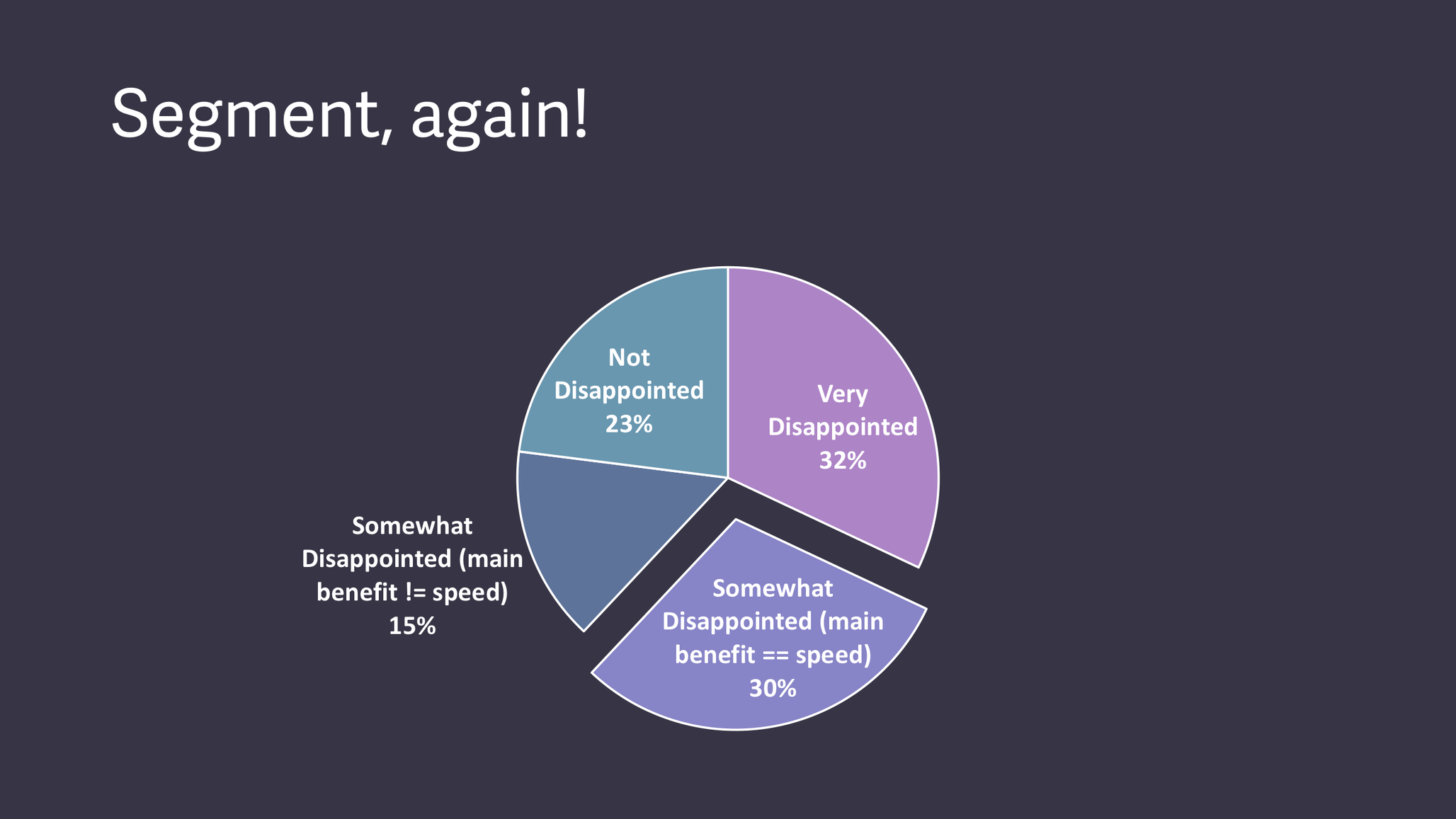
After splitting the somewhat disappointed group into 2 new segments around speed, here's how we decided to act on their feedback:
在将有些失望的群体按照速度分成两个新的细分群体后,以下是我们决定如何根据他们的反馈采取行动:
Somewhat disappointed users for whom speed was not the main benefit: we opted to politely disregard them, as our main benefit did not resonate. Even if we built everything they wanted, they would be unlikely to fall in love with the product.对于那些速度不是主要优势的用户来说,他们感到有些失望:我们选择礼貌地忽视他们,因为我们的主要优势并没有引起他们的共鸣。即使我们建造了他们想要的一切,他们也不太可能会爱上这个产品。
Somewhat disappointed users for whom speed was the main benefit: we paid very close attention to this group, because our main benefit did resonate. Something — probably something small — held them back.
对于那些速度是主要优势的用户来说,他们有些失望:我们非常关注这个群体,因为我们的主要优势确实引起了共鸣。有些东西——可能是一些小事——阻碍了他们。
Focusing on this last group, we looked more closely at their answers to the 4th question on our survey: "How can we improve Superhuman for you?"
针对最后一组,我们更仔细地研究了他们对我们调查中第 4 个问题的回答:"我们如何为您改进 Superhuman?"
This is what we saw:
这是我们所看到的:

After some analysis, we found that the main thing holding back our users was simple: our lack of a mobile app. In 2015, we had taken the contrarian approach of starting with the desktop. Most emails are sent from desktop, so that's where we thought we could add most value. We were always planning on building a mobile app, but at the beginning of our journey — like every startup — we had the chips for just 1 bet. In 2017, it was clear that we could no longer delay this, and that mobile had become critical for product-market fit.
经过一些分析,我们发现限制用户的主要因素很简单:我们缺少移动应用。2015 年,我们采取了一种反主流的方法,从桌面版开始。大多数电子邮件都是从桌面发送的,所以我们认为在那里我们能创造最大价值。我们一直计划开发移动应用,但在我们旅程的开始阶段——像每个初创公司一样——我们只能下一次赌注。到了 2017 年,很明显我们不能再拖延了,移动应用对于产品市场契合度变得至关重要。
Probing further, we found some less obvious and more interesting requests: integrations, attachment handling, calendaring, unified inbox, better search, read receipts and so on into the long tail.
进一步探究,我们发现了一些不太明显但更有趣的需求:集成、附件处理、日程安排、统一收件箱、更好的搜索功能、已读回执等,这些需求一直延伸到长尾。
For example, as an early-stage company, internally we weren't making heavy use of our calendar and we wouldn't have prioritized calendaring much at all based on our own intuitions about email. Hence, this process of digging through feedback massively moved calendaring up on the product priorities list.
例如,作为一家早期公司,我们内部并没有大量使用日历功能,基于我们对电子邮件的直觉判断,我们原本不会优先考虑日历功能。因此,通过深入分析反馈的这个过程,极大地提升了日历功能在产品优先级列表中的地位。
With a clear understanding of our main benefit and the missing features, all we had to do was funnel these insights back into how we were building Superhuman. Implementing this segmented feedback would help the somewhat disappointed users get off the fence and move into the territory of enthusiastic advocates.
在清楚了解我们的主要优势和缺失功能后,我们要做的就是将这些洞见反馈到我们构建 Superhuman 的方式中。实施这种分段反馈将有助于那些略感失望的用户从犹豫不决转变为热情的支持者。
3. Build your roadmap by doubling down on what users love and addressing what holds others back
3. 通过加倍重视用户喜爱的内容并解决阻碍其他人的问题来构建你的路线图
Even though we understood why users loved our product, and what held others back, it wasn't initially clear how we were going to navigate the tension between the 2 when it came to committing to a product roadmap.
尽管我们了解用户为什么喜欢我们的产品,以及什么阻碍了其他人,但在制定产品路线图时,我们最初并不清楚如何平衡这两者之间的矛盾。
I eventually came to this realization: If you only double down on what users love, your product-market fit score won't increase. If you only address what holds users back, your competition will likely overtake you. This insight guided our product planning process, effectively writing our roadmap for us.
我最终意识到:如果你只专注于用户喜爱的方面,你的产品市场契合度不会提高。如果你只解决阻碍用户的问题,你的竞争对手可能会超越你。这个洞见指导了我们的产品规划过程,实际上为我们制定了路线图。
To double down on what our very disappointed users loved, half of our roadmap was devoted to the following themes:
为了加倍专注于我们非常失望的用户所喜爱的内容,我们的路线图有一半都致力于以下主题:
More speed. Superhuman was already extremely fast, but we worked to make it even faster. For example, the UI would respond within 100 ms, and search was faster than in Gmail. We pushed even further to response times of less than 50 ms, and worked to make search feel instantaneous.
更快的速度。Superhuman 原本已经非常快,但我们努力使它变得更快。例如,用户界面会在 100 毫秒内响应,搜索速度比 Gmail 更快。我们进一步将响应时间缩短到不到 50 毫秒,并努力使搜索感觉瞬时完成。
More shortcuts. Users loved that they could do everything from the keyboard. So we made our shortcuts even more robust and comprehensive. We built shortcuts that no other email experience had and we started pipelining keystrokes, ensuring that everything still worked even if you typed faster than your machine could handle.
更多快捷键。用户喜欢可以用键盘完成所有操作。因此,我们使快捷键变得更加强大和全面。我们创建了其他电子邮件体验所没有的快捷键,并开始对按键进行流水线处理,确保即使你的输入速度快于机器处理速度,一切仍然能正常运作。
More automation. Users really valued the ability to be more efficient with their time. But we all hit the same limit: the sheer time it takes to type. So we built Snippets, a feature that lets users automatically type phrases, paragraphs, or whole emails. To save even more time, we made Snippets more robust, adding the ability to include attachments, automatically add people to CC, and even integrate with a CRM and ATS.
更多自动化。用户非常重视能够更高效地利用时间的能力。但我们都遇到了同样的限制:打字所需的时间。因此,我们开发了 Snippets 功能,让用户可以自动输入短语、段落或整封电子邮件。为了节省更多时间,我们增强了 Snippets 功能,增加了包含附件、自动添加抄送人员,甚至与 CRM 和 ATS 集成的能力。
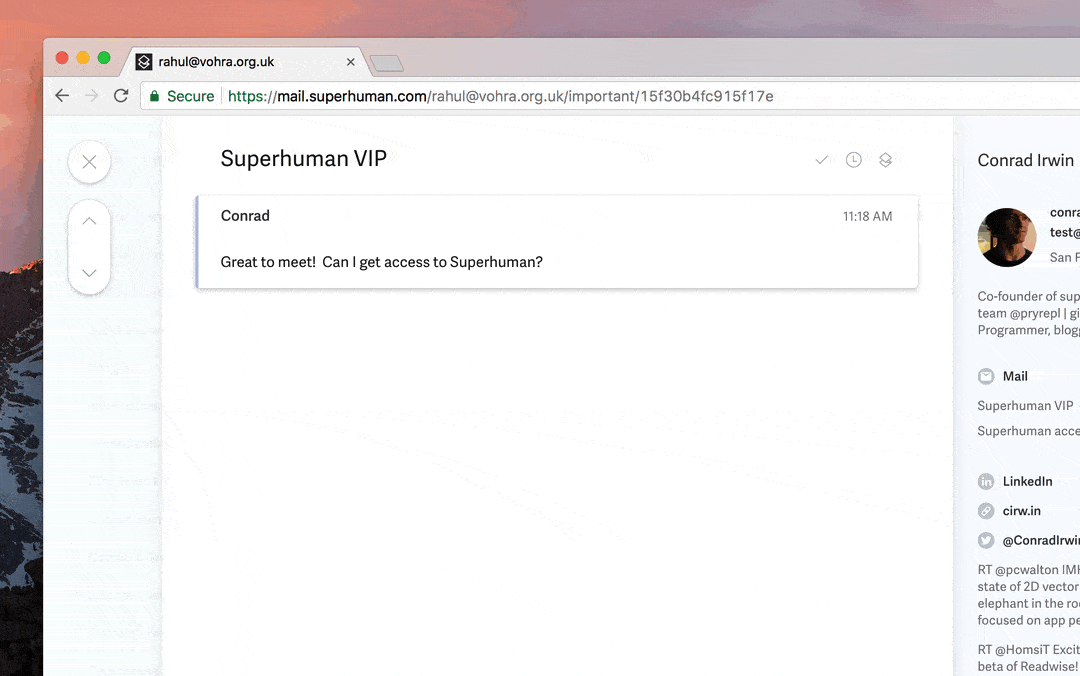
Superhuman Snippets
超人片段
More design flourishes. In our feedback, we saw that users loved the design and its many small details, so we invested in hundreds of small touches to show that we care. For example, typing "-->" now automatically turns into a right arrow: →.
更多设计亮点。在我们的反馈中,我们看到用户喜欢这个设计及其许多小细节,因此我们投入了数百个小巧思来展示我们的用心。例如,输入"-->"现在会自动转换成右箭头:→。
To gain ground with our speed-loving-yet-somewhat-disappointed users, the other half of our roadmap was focused here:
为了赢得我们热爱速度但又有些失望的用户的青睐,我们路线图的另一半集中在以下方面:
- Developing a mobile app.
开发移动应用程序。
- Adding integrations.
添加集成
- Improving attachment handling.
改进附件处理。
- Introducing calendaring features.
引入日历功能。
- Creating a unified inbox option.
创建统一收件箱选项。
- Making search better.
让搜索变得更好。
- Rolling out read receipts.
推出已读回执功能。
To stack-rank amongst these initiatives, we used a very simple cost-impact analysis: we labelled each potential project as low/medium/high cost, and similarly low/medium/high impact. For the second half of the roadmap, addressing what held people back, the impact was clear from the number of requests any given improvement had. For the first half of the roadmap, doubling down on what people love, we had to intuit the impact. This is where "product instinct" comes in, and that's a function of experience and deeply empathizing with users. (The HXC profile exercise from earlier helps a great deal with developing this muscle.)
为了对这些计划进行堆栈排序,我们使用了一个非常简单的成本-影响分析:我们将每个潜在项目标记为低/中/高成本,同样也标记为低/中/高影响。对于路线图的后半部分,解决阻碍人们的问题,影响力从任何给定改进的请求数量中可以清楚地看出。对于路线图的前半部分,加倍关注人们喜欢的内容,我们必须凭直觉判断影响。这就是"产品直觉"发挥作用的地方,它是经验和深度同理用户的函数。(之前的 HXC 描述练习对培养这种能力有很大帮助。)
With this plan of attack outlined, we got to work, starting with the lowest hanging fruit of low cost, high impact work so we could deliver improvements immediately.
有了这个攻击计划的概述,我们开始着手工作,首先从低成本、高影响力的最容易实现的工作开始,这样我们就能立即交付改进。
To increase your product-market fit score, spend half your time doubling down on what users already love and the other half on addressing what's holding others back.
为了提高产品市场契合度评分,把一半时间用于加倍发展用户已经喜爱的内容,另一半时间用于解决阻碍其他用户的问题。
4. Repeat the process and make the product-market fit score the most important metric
4. 重复这个过程,并将产品市场匹配得分作为最重要的指标
As time went on, we constantly surveyed new users to track how our product-market fit score was changing. (We were careful to ensure that we didn't survey users more than once, so as to not throw off the 40% benchmark.)
随着时间的推移,我们不断调查新用户,以追踪我们的产品市场匹配得分如何变化。(我们小心确保不会重复调查同一用户,以免影响 40%的基准。)
The percentage of users who answered "very disappointed" quickly became our most important number. It was our most highly visible metric, and we tracked it on a weekly, monthly and quarterly basis. To make this easier to measure over time, we built some custom tooling to constantly survey new users and update our aggregate numbers for each timeframe. We also refocused the product team, creating an OKR where the only key result was the very disappointed percentage so we could ensure that we continually increased our product-market fit.
回答"非常失望"的用户百分比很快成为我们最重要的数字。它是我们最显眼的指标,我们每周、每月和每季度都会跟踪它。为了更容易地长期测量这一指标,我们构建了一些自定义工具,不断调查新用户并更新每个时间段的总体数据。我们还重新调整了产品团队的方向,创建了一个 OKR,其中唯一的关键结果就是"非常失望"的百分比,以确保我们能持续提高产品市场契合度。
Reorienting Superhuman around this single metric paid off. When we started this journey in the summer of 2017, our product-market fit score was 22%. After segmenting to focus on the very disappointed set of users, we were at 33%. Within just three quarters of our work to improve the product, the score nearly doubled to 58%.
围绕这一单一指标重新定位 Superhuman 带来了回报。当我们在 2017 年夏天开始这段旅程时,我们的产品市场契合度得分为 22%。在细分以聚焦于非常失望的用户群后,我们达到了 33%。仅仅在三个季度的产品改进工作后,得分几乎翻倍至 58%。
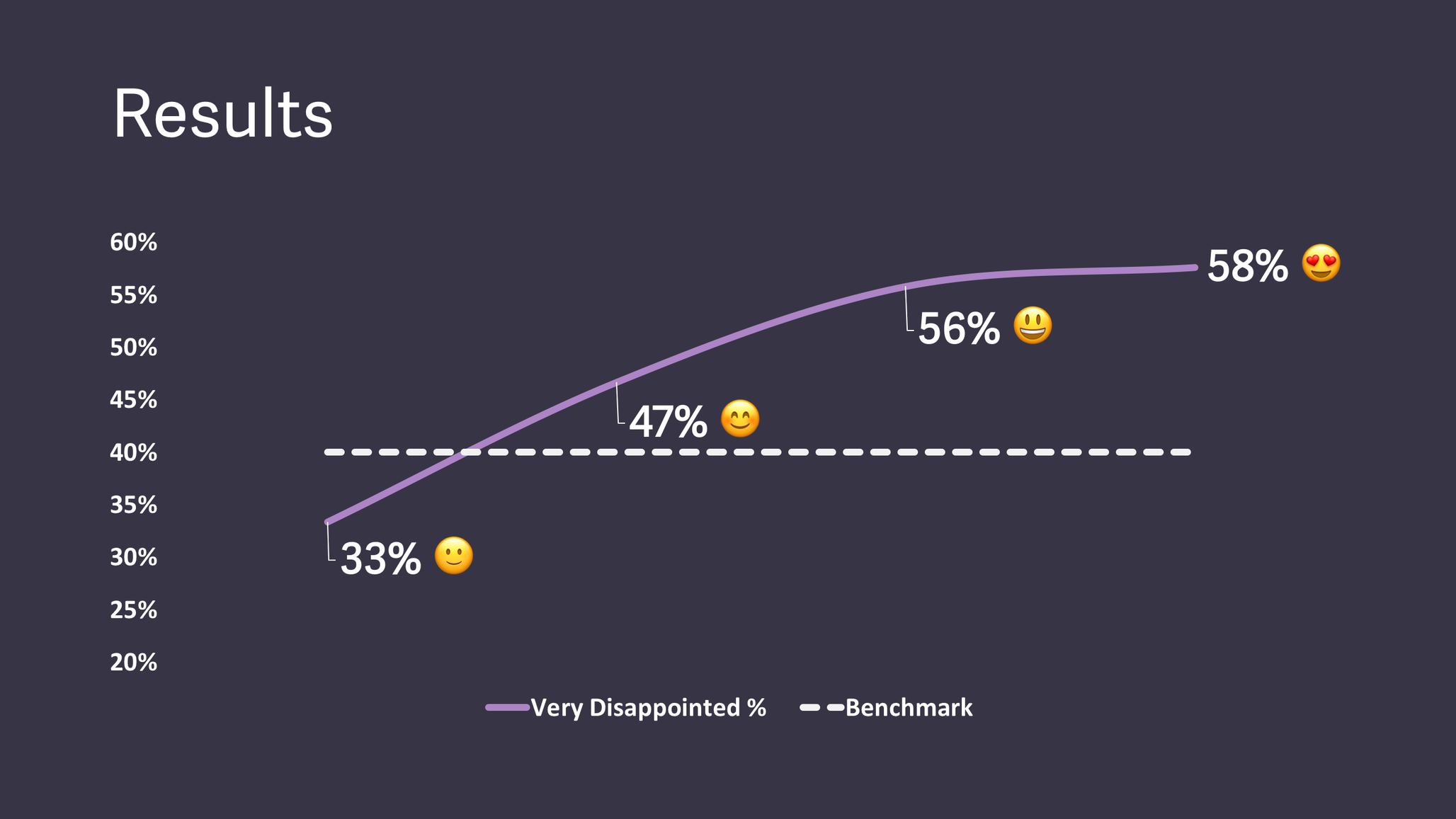
And we're not done — the product-market fit score is something that we're going to continue to track. I think it's always useful for startups to look at this metric, because as you grow you'll encounter different kinds of users. Early adopters are more forgiving, and will enjoy your product's primary benefit despite its inevitable shortcomings. But as you push beyond this group, users become much more demanding, requiring feature parity with their current products. Your product-market fit score may well drop as a result.
我们还没有完成 — 产品市场契合度得分是我们将继续跟踪的指标。我认为创业公司始终关注这个指标很有用,因为随着公司成长,你会遇到不同类型的用户。早期采用者更宽容,他们会享受你产品的主要优势,尽管它不可避免地存在缺点。但当你推广到这个群体之外时,用户会变得更加苛刻,要求与他们当前使用的产品在功能上保持一致。因此,你的产品市场契合度得分可能会下降。
However, this shouldn't cause too much anxiety, as there are some ways around it. If your business has strong network effects (think Uber or Airbnb), then the core benefit will keep getting better as you grow. If you're a SaaS company like Superhuman, you simply have to keep on improving the product as the pool of users expands. To do that, we rebuild our roadmap every quarter using this process, ensuring that we're improving our product-market fit score fast enough.
然而,这不应引起太多焦虑,因为有一些方法可以解决这个问题。如果您的企业具有强大的网络效应(想想优步或爱彼迎),那么核心利益将随着增长而不断改善。如果您是像 Superhuman 这样的 SaaS 公司,您只需要随着用户群的扩大不断改进产品。为此,我们每季度都使用这个流程重建我们的路线图,确保我们能够足够快地提高产品市场契合度得分。
Bracing for impact 准备迎接冲击
In the twists and turns of following this process, I found a way to define product-market fit and a metric to measure it. Our team had a single number to rally around, instead of an abstract goal that left us feeling hopeless. By surveying our users, segmenting our supporters, learning what users loved and what held them back, and then dividing a roadmap between the 2, we found a methodology to increase product-market fit.
在遵循这一过程的曲折中,我找到了定义产品市场匹配度的方法和衡量它的指标。我们团队有了一个可以团结在一起的具体数字,而不是一个让我们感到绝望的抽象目标。通过调查用户、细分支持者、了解用户喜欢什么和阻碍他们的因素,然后将路线图分为两部分,我们找到了一种提高产品市场匹配度的方法。
It is hard to overstate the impact of this product-market fit engine on our company. Everything we do at Superhuman — from hiring to selling and marketing to raising capital — has become significantly easier.
很难夸大这个产品市场契合引擎对我们公司的影响。Superhuman 的一切工作——从招聘到销售和营销再到筹集资金——都变得容易得多。
Our team grew to 22 people and our NPS has increased right alongside our product-market fit score. Users became noticeably more vocal about how much they loved the product, both in our surveys and on social media. Current investors started asking if they could put in more money ahead of upcoming rounds while outside investors continually ask me if they can invest.
我们的团队增长到 22 人,我们的净推荐值(NPS)与产品市场契合度得分一同提高。用户在我们的调查和社交媒体上变得明显更积极地表达他们对产品的喜爱。现有投资者开始询问是否可以在即将到来的融资轮前投入更多资金,而外部投资者则不断询问我是否可以让他们投资。
Taking a step back to reflect on what I've learned from building this product-market fit engine for Superhuman, I'm left with 2 final takeaways:
回顾我从为 Superhuman 构建这个产品市场契合度引擎中学到的东西,我得出了两个最终的体会:
- Investors advising early-stage teams should avoid pushing for growth ahead of product-market fit. As an industry, we all know that this ends in disaster, yet the pressure for premature growth is still all too common. Startups need time and space to find their fit and launch the right way.
建议早期团队的投资者应避免在产品与市场匹配之前推动增长。作为一个行业,我们都知道这会导致灾难性后果,但过早增长的压力仍然很普遍。初创公司需要时间和空间来找到自己的定位并以正确的方式推出产品。
- For any founder looking to get out of the wilderness and on the path to the ever elusive product-market fit, I've been in your shoes — and I hope you'll consider retooling this engine in those proverbial startup garages to make it your own. When you finally hit the product-market fit score you're targeting, my advice is to push the pedal all the way down and grow as fast as you can. It will feel uncomfortable, but you'll have the evidence you need to know that you’ll succeed.
对于任何想要走出迷茫、寻找那个难以捉摸的产品市场契合度的创始人来说,我曾经也处于你们的境地 — 我希望你们能在那些传说中的创业车库里重新调整这个引擎,使之成为你们自己的。当你最终达到你所瞄准的产品市场契合度分数时,我的建议是把油门踩到底,尽可能快地增长。这可能会让你感到不适,但你将拥有所需的证据,知道你会成功。
If you would like to try this engine for yourself, check out this interactive tool, with a sample of actual Superhuman results. You can see the word clouds change as you play around with it — and you can also put in your own data and use it to build your own product.
如果您想亲自尝试这个引擎,可以查看这个互动工具,其中包含了实际的 Superhuman 结果样本。当您使用它时,您可以看到词云的变化——您也可以输入自己的数据,并用它来构建自己的产品。
This piece was first published in First Round Review on November 13, 2018.
这篇文章最初发表于 2018 年 11 月 13 日的 First Round Review。
